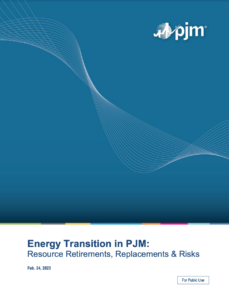Full Title: Energy Transition in PJM: Resource Retirements, Replacements & Risks
Author(s): PJM
Publisher(s): PJM
Publication Date: February 24, 2023
Full Text: Download Resource
Description (excerpt):
Driven by industry trends and their associated challenges, PJM developed the following strategic pillars to ensure an efficient and reliable energy transition: facilitating decarbonization policies reliably and cost-effectively; planning/operating the grid of the future; and fostering innovation. In support of these strategic objectives, PJM is continuing a multiphase effort to study the potential impacts of the energy transition. The first two phases of the study focused on energy and ancillary services and resource adequacy in 2035 and beyond. This third phase focuses on resource adequacy in the near term through 2030. Maintaining an adequate level of generation resources, with the right operational and physical characteristics, is essential for PJM’s ability to serve electrical demand through the energy transition.
Our research highlights four trends below that we believe, in combination, present increasing reliability risks during the transition, due to a potential timing mismatch between resource retirements, load growth and the pace of new generation entry under a possible “low new entry” scenario: 1) The growth rate of electricity demand is likely to continue to increase from electrification coupled with the proliferation of high-demand data centers in the region. 2) Thermal generators are retiring at a rapid pace due to government and private sector policies as well as economics. 3) Retirements are at risk of outpacing the construction of new resources, due to a combination of industry forces, including siting and supply chain, whose long-term impacts are not fully known. 4) PJM’s interconnection queue is composed primarily of intermittent and limited-duration resources. Given the operating characteristics of these resources, we need multiple megawatts of these resources to replace 1 MW of thermal generation.
